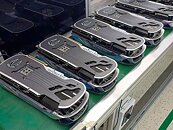- Joined
- Oct 9, 2007
- Messages
- 47,890 (7.38/day)
- Location
- Dublin, Ireland
| System Name | RBMK-1000 |
|---|---|
| Processor | AMD Ryzen 7 5700G |
| Motherboard | Gigabyte B550 AORUS Elite V2 |
| Cooling | DeepCool Gammax L240 V2 |
| Memory | 2x 16GB DDR4-3200 |
| Video Card(s) | Galax RTX 4070 Ti EX |
| Storage | Samsung 990 1TB |
| Display(s) | BenQ 1440p 60 Hz 27-inch |
| Case | Corsair Carbide 100R |
| Audio Device(s) | ASUS SupremeFX S1220A |
| Power Supply | Cooler Master MWE Gold 650W |
| Mouse | ASUS ROG Strix Impact |
| Keyboard | Gamdias Hermes E2 |
| Software | Windows 11 Pro |
NVIDIA's next-generation AD102 "Ada" GPU is shaping up to be a monstrosity, with a rumored transistor-count north of 75 billion. This would put over 2.6 times the 28.3 billion transistors of the current-gen GA102 silicon. NVIDIA is reportedly building the AD102 on the TSMC N5 (5 nm EUV) node, which offers a significant transistor-density uplift over the Samsung 8LPP (8 nm DUV) node on which the GA102 is built. The 8LPP offers 44.56 million transistors per mm² die-area (MTr/mm²), while the N5 offers a whopping 134 MTr/mm², which fits in with the transistor-count gain. This would put its die-area in the neighborhood of 560 mm². The AD102 is expected to power high-end RTX 40-series SKUs in the RTX 4090-series and RTX 4080-series.

View at TechPowerUp Main Site | Source

View at TechPowerUp Main Site | Source








